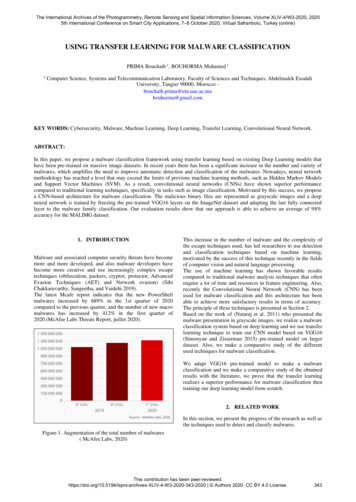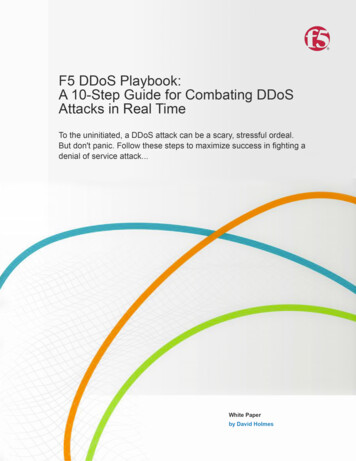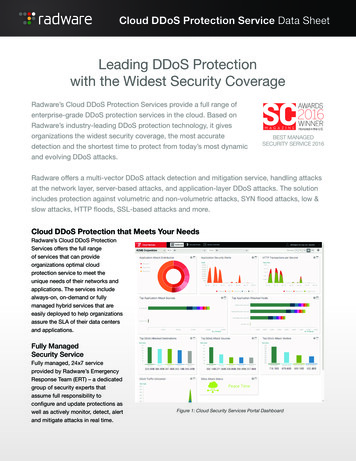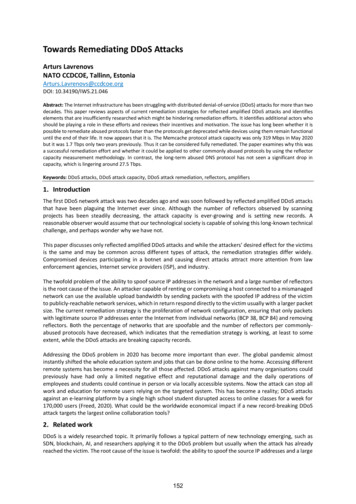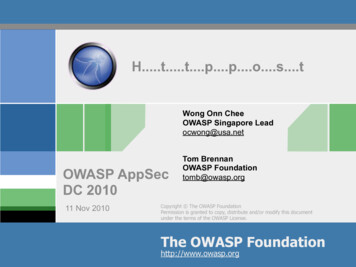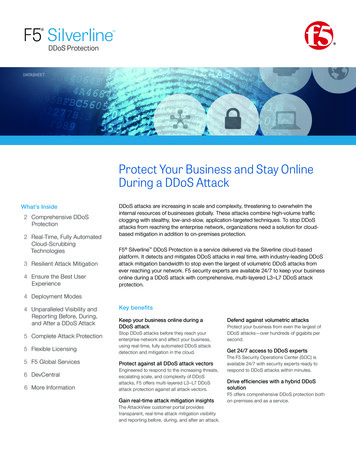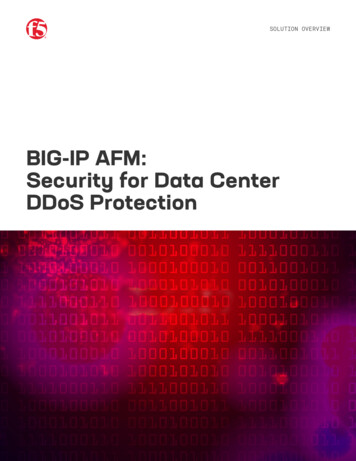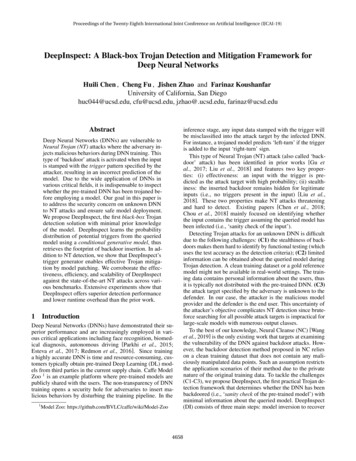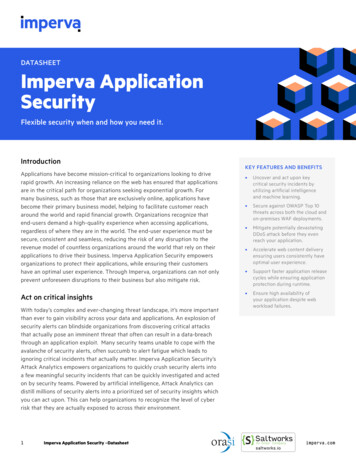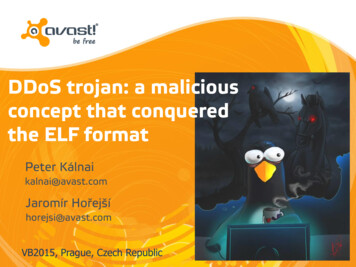
Transcription
DDoS trojan: a maliciousconcept that conqueredthe ELF formatPeter Kálnaikalnai@avast.comJaromír Hořejšíhorejsi@avast.comVB2015, Prague, Czech Republic
Outline ELF Malware space & HistoryCommon characteristics of malwareAutostart (Persistence)Infection chain– Methods of intrusion Cybercriminals’ operation tools––––Bot builders and C&C panelsHFS listingsBrute-forcersVulnerability & Port scanners DDoS Trojans (Elknot, MrBlack, Gafgyt, Xorddos, Chinaz Targets Summary
ELF malware space Visualization using Gephi– The ForceAtlas2 graph layout algorithm– Clustered 12 thousand unique malicious ELF files inSeptember 2015– Nodes: malware families with samples grouped bysignatures; the size of stars correlates with thenumber of unique files– Edges: nodes connected with an undirected edge ifthey share a signature– 6 categories (Viruses; Exploits & PoC; Trojans; DDoSTrojans; parts of Android packages; Unclassified)– Excluded: truncated files; parts of potentiallyunwanted APKs
History The first documented DDoS attack, 2000 ( the internet tookover the half of global communication, 1999) (Edwards, Nazario (ArborNetworks)) “A Survey ofContemporary Chinese DDoS Malware”, VB2011, Barcelona First builder of Linux flooding bot received at our backend,November 2013 (Secure Honey) “Trojan Horse Uploaded”, November 2013 (MalwareMustDie!) : “Let's be more serious about (mitigating)DNS Amp ELF hack attack”, December 2013 (ELF:Elknot) (ValdikSS) “Исследуем” Linux Botnet «BillGates»”, February2014 (ELF:Elknot (Setag)) (Dr. Web) “DDoS Trojans attack Linux”, May ‘14, (ELF:MrBlack) (Kaspersky) “Shellshock and its early adopters”, September2014, (ELF:Gafgyt) Virustotal added “File detail” tab with parsed ELFcharacteristics, December 2014
History (MalwareMustDie!) “Fuzzy reversing a new China ELF"Linux/XOR.DDoS"”, September 2014 (Avast) “Linux DDoS Trojan hiding itself with an embeddedrootkit”, January 2015 (ELF:Xorddos) (MalwareMustDie!) “New ELF malware on Shellshock: theChinaZ”, January 2015 (ELF:Chinaz) (Krebs on Security) “Lizard Stresser Runs on Hacked HomeRouters”, January 2015 (ELF:Gafgyt) (FFRI, Inc) “Latest Trends in Linux Malware”, January 2015 (Novetta) “The Elastic Botnet Report”, February 2015 (Trustwave) “FHS Null Byte Attack (CVE-2014-6287) Attemptsto Install DDoS Malware (Iptablex)”, Feb 2015 (Talos, Cisco) “It Takes a Village SSHPsychos”, April 2015 (Kaspersky) DDoS Intelligence Report Q2, August 2015
Common ELF characteristics The ELF header– e type: executable file or shared object– e machine with prefix “EM ” followed by 386, x86 64,ARM, MIPS, SH, PPC, SPARC or M68K Segments– Described by program headers– Segments contain one or more sections Sections– Names (.bss, .init, .got, .plt, .rel, .rodata, .strtab,.symtab, .text)– Special types (SYMTAB, STRTAB) contain also importedand exported symbols; affected by the process ofstripping harder reverse engineering– .rodata usually contains character strings
Common ELF characteristics Static properties–––––Trojanized flooding toolsSignificant portion of code shared among all the variantsWritten mostly in C/C Debug info often not strippedVariety of supported flooding methods UDP, TCP/SYN, ICMP, DNS, DNS amplification– Killing competing resource consuming processes– In plain form or packed with UPX UPX sometimes modified to avoid unpacking by the original UPX tool– Modified magic value– Checksums do not match
Autostart / Persistence In a strict sence DDoS trojan is a DDoS tool with anautostart Methods of autostart / persistence found in-the-wild:– (A1) /etc/init.d/ startup scripts copied here– (A2) /etc/cron. S S from { hourly, daily, weekly, monthly } A service can be added to /etc/crontab– (A3) /etc/rc N .d/ Symbolic links to startup scripts N is a runlevel indicator (Halt 0; Single-user 1; Multi-user2-5; Reboot 6) Alternatively, path can be added to /etc/rc.local
Infection chain Attackers– build ELF malwareusing a customizedbuilder– start Http File Server(HFS), which will behosting the previouslybuilt malicious binaries– run port scanners on IPranges– Some of thedistributed Windowsbinaries infected by fileinfector Win32:Parite
Infection chain If a desired port opened– script exploiting a vulnerability CVE-2014-3120 – Elasticsearch RCE, recorded by MMD! Targets Linux machines– Shellshock vulnerabilities– MS08-067 – Vulnerability in Server Service Targets windows machines– SSH brute force attack Lists of user names and passwords Runs from windows machine, targets Linux servers– Apache Struts vulnerabilities
Infection chain Data files acquired from HFS listings– Lists of target IPs– Password lists– Result of a port scan (wineggdrop) as found in an archiveon a compromised machine– About 2M IPs scanned and 14K hosts with open port 22found
Cybercriminals’ operation tools Bot builders
Cybercriminals’ operation tools C&C panels
Cybercriminals’ operation tools C&C panels
Cybercriminals’ operation tools HTTP File Server (HFS) listings– It’ binaries sometimes found downloadable from HFS listings– Count of downloads can help to estimate number of infectedmachines and size of botnet
Cybercriminals’ operation tools Vulnerability scanners & exploits– MS08-067(RCE in Windows Server Service)– Apache Struts from ChinaZ:
Cybercriminals’ operation tools SSH brute-forcer– linux%d.exe scans all IPs for open port 22, tries passwords from passwd%02d.txt outputs lx pass.txt– Leaked online
Cybercriminals’ operation tools SSH uploader– ssh.exe (python script, compiled with py2exe) reads lx pass.txt, connects to each host and executes there commands from command.txt file
Cybercriminals’ operation tools Port scanners– ScanPort– WinEggDrop
DDoS Trojans - Elknot Characteristics– Presence of fake.cfg (xmit.cfg)– Available for Linux x86/x64, Windows x86/x64, FreeBSD– Command grammar supports4 tasks StartTask, StopTask,WriteFake, SendStatus– Lightweight text-box builders and an advancedbuilder (shown before)
DDoS Trojans - Elknot C&C address and port are hardcoded in binary andencrypted by a simple algorithm2-91/0:0/112/862-1 1-1 1-1 1-1 1-1 1-1-1 1-1 1-1 1.82.191.2010771
DDoS Trojans - Elknot Supported methods– SYN, UDP,
DDoS Trojans - Elknot Target IP, port, number of threads, attack time
DDoS Trojans - MrBlack Tool with source code available Trojanized extensions dubbed Aesddos and WrkAtkwith the autostart feature Contains various character strings:– VERS0NEX, Mr.Black, Hacker, MainSocket, DealWithDDoS List of attack supporting procedures– DNS Flood, SYN Flood, UDP Flood, UDPS Flood, TCP Flood,CC Flood, CC2 Flood, CC3 Flood, etc Executables for Linux operating systems available forarchitectures:– EM x86 64, EM 386, EM MIPS, EM ARM Control panel named “Sword Linux” (shown earlier)
DDoS Trojans - Gafgyt Detection name for Lizzard Stresser DDoS Tool Source code leaked in January 2015; available bothclient and server side Intrusion via– Brute-forcing telnet– Shellshock vulnerabilities IRC bot with implemented client commands:– PING, GETLOCALIP, SCANNER, TCP, UDP, DNS, KILLATTK,LOLNOGTFO Threat No. 1 for embedded devices:– EM 386, EM x86 64, EM SPARC, EM PPC, EM SH, EM ARM,EM MIPS and EM 68K
DDoS Trojans - Xorddos Intrusion starts with SSH brute-forcing Installation script– gets kernel version,– (optional) uploads kernel header,– downloads a customized trojan binary with embedded LKM LKM based on an open-source rootkit called Suterusu,available on Github Heavy autostart features– Repeated self-installation under random name in /boot andexecuted; to avoid termination via kill command C&C communication encrypted in both directions withhard-coded XOR key (BB2FA36AAA9541F0)
DDoS Trojans - Xorddos Configuration file (Elimination of rivals)– Options: md5, denyip, filename, rmfile– List of competing processes and files Red Elknot / SetagViolet SotdasGreen ElknotBlue MrBlack
DDoS Trojans - Xorddos Control panel– Controls two infected devices (EM 386, EM ARM)
DDoS Trojans - ChinaZ Source code available on Github (a project DDoSClient) Volumetric attacks– SYN, UDP, ICMP, DNS Multiple platforms– EM 386, EM x86 64, EM MIPS Samples often compressed with UPX Instruction videos leaked on Chinese forums– Web control panel– Control panel with Windows GUI
DDoS Trojans - ChinaZ C&C panel
DDoS Trojans - ChinaZ
Targets Attack commands targeting various web services Targeting small or medium sized local businesses– Profitability depends of ability to stay online– Usually not hosted on major Content Delivery Networks(natural protection against DDoS): online gaming site; onlinecasinos; e-commerce shops; forums– ELF:Xorddos an exception attacking the infrastructure oflarge providers (Google Cloud, Global Flag (hosting gameservers like Counter Strike or Day of Defeat); CloudFlare;Sharktech; OVH Hosting; Microsoft Hosting; Amazon Cloud;Akamai Tech.) Effect of DDoS directly observed:– sites unreachable during the process of receiving attackcommands– reachability recovered after the process stopped
Summary DDoS Trojans: threat No 1. for servers and embeddedsystems running Linux Variety of projects available on code sharing sites orforums Autostart is a desired and advanced feature Similar attack methods implemented Little attempts to cover the functionality by strippingor by (modified) UPX Increased detection rates by AV solutions distributors of malware careless about detecting yet Targets are both small/medium business and serviceshosted by large CDNs
Acknowledgement Information and data exchange:– @benkow– Christian Rebischke (@sh1bumi)– Lin Song (University of Iowa)– Threat Inc. (@threat inc)– Yin Minn Pa Pa, Shogo Suzuki, Katsunari Yoshioka, TsutomuMatsumoto, Takahiro Kasama, Christian Rossow (YokohamaNational University, Japan; National Institute of Information andCommunications Technology, Japan; Saarland University, Germany)IoTPOT: Analysing the Rise of IoT s/iotpot-woot2015.pdf) Open sharing:– MalwareMustDie!, NPO (@malwaremustdie)– @TekDefense– @da 667
Questions & Answerswww.campuscafe.cz, Nadobro s.r.o. 2015
DDoS trojan: a malicious concept that conquered the ELF format . Outline ELF Malware space & History Common characteristics of malware Autostart (Persistence) Infection chain -Methods of intrusion Cybercriminals' operation tools -Bot builders and C&C panels -HFS listings -Brute-forcers -Vulnerability & Port scanners DDoS Trojans (Elknot, MrBlack, Gafgyt .
